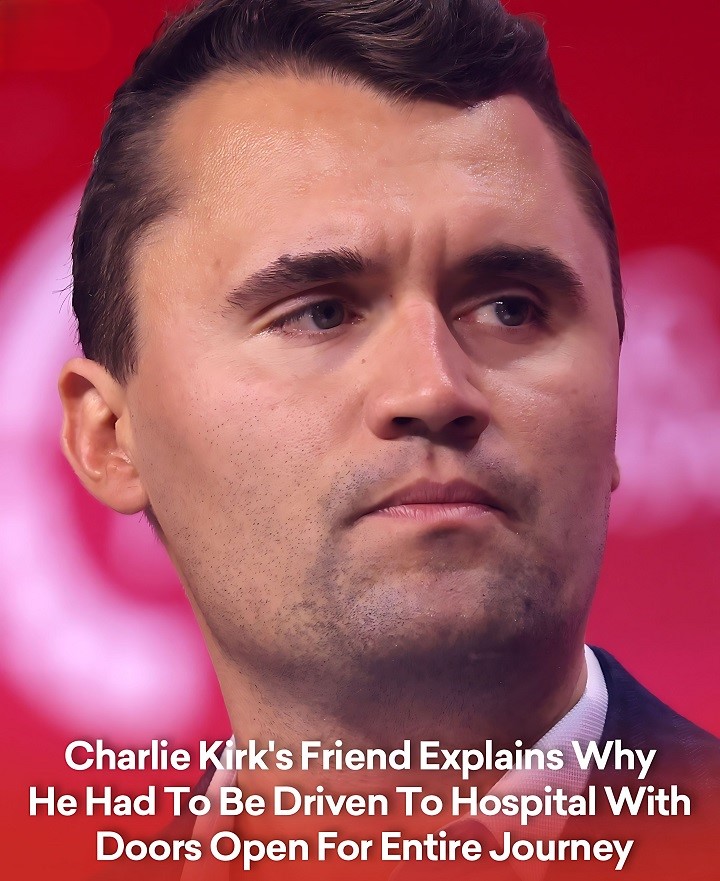A close friend and mentor of Charlie Kirk has explained why the SUV rushing the conservative activist to hospital moments after he was shot sped through Orem, Utah, with a passenger door hanging open: Kirk’s height and the need to continue CPR meant it could not be closed. Christian apologist Frank Turek, who was beside Kirk when a single round struck him in the neck during a 10 September campus event at Utah Valley University, said he jumped into the vehicle with security and aided efforts to keep Kirk alive as the driver headed for Timpanogos Regional Hospital. “Charlie’s so tall, we can’t close the door. We drove four miles… all the way to the hospital with the door open,” Turek said in a podcast account released days after the killing.
Turek, a longtime adviser who has described Kirk as “literally a son to me,” said the decision to leave immediately in the team’s SUV came in the seconds after the shot as security applied pressure to the wound and bystanders scattered. “If your son got hit, what would you do?… I got in the car because if there was any way I could save him, I had to do something,” he said. He recounted shouting “Come on, Charlie! Come on! Come on!” while chest compressions were performed in the moving vehicle. According to Turek’s timeline, the team covered several miles to the hospital with the door ajar because Kirk’s legs extended past the sill while he was laid out for CPR.
The account, delivered on Turek’s CrossExamined show and amplified by outlets quoting his remarks, offers a direct explanation for a detail that appeared in early video and witness descriptions from the scene: an SUV departing the Utah Valley University courtyard quickly with a rear door still open. Turek’s narrative indicates the configuration was necessary to keep Kirk flat and accessible for resuscitation attempts while maintaining speed to the nearest trauma centre. He said the driver “just go, go, go” through intersections as the group tried to stop the bleeding and sustain breathing en route.

Kirk, 31, the founder of conservative youth organization Turning Point USA, was hit by a single rifle round as he took questions after a speech on campus. He was transported to Timpanogos Regional Hospital in Orem, where doctors briefly restored a pulse before a surgeon pronounced him dead, Turek said, adding that hospital staff later described the injuries as “catastrophic.” Orem police and federal agents said the fatal shot was fired from an elevated position near the university library; a suspect was later taken into custody.
Turek said he was standing roughly 30 feet to Kirk’s right as the activist fielded a question when he heard the crack of a shot and saw Kirk fall backward. He said he and members of Kirk’s security detail lifted the wounded man into their SUV, with one operative maintaining pressure at the neck while Turek and another team member attempted chest compressions. “Charlie is laid out right in front of me,” Turek said. “Charlie wasn’t there. His eyes were fixed. He wasn’t looking at me. He was looking past me right into eternity.” Turek said his view, based on what hospital staff later told the group, was that Kirk died instantly and “felt absolutely no pain.”
The friend’s description aligns with reporting that placed the hospital minutes from the Utah Valley University campus, and his estimate that the vehicle traveled “four miles” with a door open matches the rough point-to-point journey through Orem’s surface streets to the emergency department. Photographs published in the days after the shooting showed crowds gathered outside Timpanogos Regional Hospital, where family members and associates arrived as news of the attack spread.
In additional remarks, Turek said medics told the family Kirk’s wound was unsurvivable. He said a physician relayed that a pulse was regained briefly, but the damage to major vessels in the neck meant there was no prospect of recovery. “If that’s any comfort at all, Charlie didn’t suffer,” Turek said on the broadcast, adding a devotional gloss that “absent from the body, present with the Lord” captured the immediacy of death after impact. He also thanked the security team for what he described as “calm” and trained actions under fire.

Media reproducing Turek’s comments, including the Hindustan Times and Tyla, highlighted the doorway detail as a striking aspect of his blow-by-blow account from inside the SUV. Both outlets quoted the same passage about Kirk’s height preventing the door from shutting and the group driving the entire way with it open while they continued resuscitation. A segment aired by Fox News included video supplied by CrossExamined in which Turek narrates the sequence between the shot and the hospital doors, repeating the “so tall” explanation and his shouted pleas as he worked over Kirk.
Authorities have said Kirk was shot during a question-and-answer session outside on the UVU campus. The following week, prosecutors announced that a 22-year-old suspect had been arrested and charged; court filings allege the attacker fired from an elevated perch with a bolt-action rifle before fleeing toward a wooded area beyond the university perimeter. As investigators build a forensic timeline, Turek’s account remains the fullest public description from inside the vehicle used to evacuate the victim.
Kirk’s death set off a national outpouring among supporters and drew a stadium-scale memorial on 21 September in Glendale, Arizona, where former President Donald Trump and Vice President JD Vance praised the activist as a “martyr for American freedom.” In an emotional moment, Kirk’s widow, Erika, told mourners, “I forgive him,” referring to the accused gunman. The service, staged at State Farm Stadium, blended worship music with political speeches and attracted tens of thousands. Against that backdrop, Turek’s granular account of the minutes after the shot—particularly the reason the SUV’s door remained open—has featured prominently in memorial reporting and rebuttals to speculation about what happened on the ground.
Frank Turek, 63, is a Christian apologist, author and broadcaster who leads the CrossExamined ministry and hosts a syndicated program under the same name. He has said Kirk sought him out years ago for mentorship in apologetics and that the two developed a father-and-son dynamic. In the episode recounting the incident, he said the pair rode to the university together on the morning of the event, discussing likely questions and answers before stepping into the courtyard where Kirk engaged a crowd of students and supporters. When the shot rang out, Turek said, he instinctively moved to help lift Kirk into the team’s SUV.
The door-ajar detail has also been echoed in social-media clips of Turek’s recounting, which gathered millions of views as the memorial service approached. In one widely shared segment, he says: “We drove four miles… I don’t know, it’s four-something miles… all the way to the hospital with the door open,” adding that he was unsure how one team member managed to stay in the car as it accelerated through traffic. The same clip shows him describing a scene of “controlled urgency” as a guard maintained pressure on the neck wound while compressions continued.
Neither the hospital nor law enforcement has released a public, minute-by-minute reconstruction of the transport, and officials have not commented on the mechanics of the rescue beyond confirming that Kirk was pronounced dead shortly after arrival. Turek’s depiction therefore serves as the primary on-the-record explanation for the open door during the drive. The practicality of continuing CPR on a supine patient in a moving vehicle would have required space; with Kirk’s frame extending past the door aperture, Turek says, the team prioritized airway and circulation over closing the door to the cabin.
In the weeks ahead, investigators are expected to disclose additional detail in court as they present evidence about the shooting and the man accused of carrying it out. For those who were with Kirk at the end, the image that lingers is not only of the shot and the panic but of a race to the hospital that left little room for anything but medical improvisation. “Charlie is laid out in front… just right in front of me,” Turek said, voicing the moment he realized the outcome would not change. “He was with Jesus already.” The plain explanation for why the SUV’s door stayed open—because there was no room to shut it without interrupting lifesaving attempts—has become a small but telling part of a larger narrative that those closest to Kirk have offered to answer proliferating questions about his final minutes.
Even amid continuing debate over security arrangements at the outdoor event, Turek and other allies have stressed the actions taken after the shot: moving Kirk immediately, maintaining pressure on the wound, keeping him flat for compressions and choosing speed over waiting for paramedics to reach the courtyard. The ride, with a door swinging open on city streets, was the visible consequence of those choices. If details of the weapon and the attacker’s vantage point have dominated early law-enforcement briefings, those who tried to save Kirk have centered their recollections on the four miles Turek says they covered with the door ajar and a single task at hand.
At the Glendale memorial, the account from inside the SUV circulated alongside tributes to Kirk’s organizing and to what colleagues described as his “noble spirit.” It also dovetailed with the widow’s message of forgiveness, a contrast that underscored the intensely personal framing of a public murder. For Turek, the open door is not an oddity but a footnote to a failed rescue: a necessary, if jarring, outcome of trying to hold compressions and speed a tall man to the nearest emergency room. As the case proceeds, and as Kirk’s colleagues resume the campus tour he planned to lead this autumn, the immediate explanation for a scene caught on shaky phone video remains the simplest one offered by an eyewitness inside the car.

